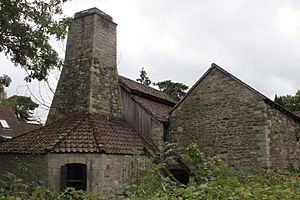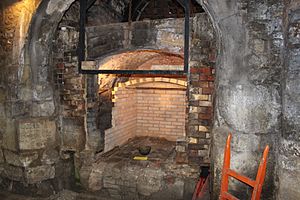Saltford Brass Mill facts for kids
Quick facts for kids Saltford Brass Mill |
|
|---|---|
| Native name Brass Battery | |
 |
|
| Location | Saltford, Somerset, England |
| Built | 1720s |
|
Listed Building – Grade II*
|
|
| Official name: Old Brass Mill | |
| Designated | 19 June 1975 |
| Reference no. | 485129 |
| Reference no. | 200983 |
| Lua error in Module:Location_map at line 420: attempt to index field 'wikibase' (a nil value). | |
The Saltford Brass Mill is a really old factory building. It sits right by the River Avon in Saltford, Somerset, England. This mill was built way back in the 1720s. It is considered a very important historic place.
People have used a watermill on this spot for a very long time. There was even one here when the Domesday Book was written. The Saltford Brass Mill is the last one left of over 30 mills that used to be along this part of the River Avon.
Contents
How Brass Was Made Here
Brass making started in Bristol around the year 1700. A family led by Abraham Darby began this work. They later moved their operations upstream to Saltford and Keynsham. This was because these areas had a better water supply for their mills.
Early Brass Ingredients
At first, the brass was made using Cornish ores. These ores were first cleaned at Crew's Hole. Then, they were brought to the mill by river. They were mixed with a mineral called calamine. This calamine came from the nearby Mendip Hills.
Changes in Making Brass
Over time, the way brass was made got better. Local copper was no longer needed. Instead, copper came from Swansea. By the 1850s, a metal called zinc was used instead of calamine. This new way of making brass was started by William Champion. He lived close to the mill.
What You Can See at the Mill
The mill has a special part called a battery mill. This part was used to make brass sheets into hollow shapes. They made things like pans, bowls, and large containers. Some of these old items are still on display today.
Heating the Brass
There is also a complete annealing furnace. This furnace was used to heat the brass. Heating the brass made it softer. This stopped the brass from cracking while workers shaped it. This furnace is thought to be one of the best examples of this old technology.
Powering the Machines
You can also see parts of the old water wheels. These wheels first powered the machines in the mill. One of these water wheels still works today! Between 1760 and 1830, the mill also started using rolling mills. These machines made metal sheets much smoother than the older battery methods.
However, the mill kept making battery ware until 1908. It was the last mill in Britain to do so.
The Mill Today
The Saltford Brass Mill stopped making brass in 1924. But in 1995, it was fixed up and brought back to life. Now, a group of volunteers helps to keep it running. They work with English Heritage and the owners, Bath and North East Somerset Council.


